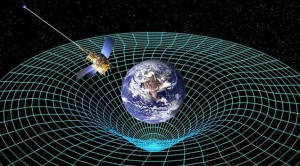
Gravity Probe B orbits earth, captured in its gravity well
Sometimes analogies just feel right. For instance, “as hard to find as a needle in a hay stack” is often a good way to describe trying to find a needed quote in a half-remembered book. The mental image and the actual task just fit. In physics, I sometimes feel like the hardest part is finding the perfect analogy that will make it possible for everyone in the class to visualize the concept I’m trying to explain. In the case of gravity, Einstein kindly provided the needed analogy. He said the way we need to think of gravity is as a divot in the 4-dimensional space-time reality, where orbiting objects simply roll around the inside of the well, like bicylcists racing around the sides of a velodrome. Ok, so maybe that analogy is a bit more challenging to follow. Nonetheless, in all its complexity this analogy points us toward one idea: If space were a surface instead of volume, the surface would curve down toward anything with mass, and it would curve more for high mass objects than low mass objects (and black holes may just tear a hole in that surface).
In this visualization of the universe, objects’ masses define the shape of space, and acceleration of a small object (like a space craft) toward and deceleration away from a larger object (like a planet) is just a side effect of the small object rolling “downhill” into a gravity well and “uphill” out of the gravity well.
This image of space leads somewhat naturally to a series of complex ideas. For instance, if you suddenly remove a mass from or change a mass on the space-time surface, you can imagine the surface rebounding, with waves moving across the surface as a result of this sudden rebound. We believe this is part of the reality of gravitational waves, which have there definition in much more complicated mathematics. Frame dragging, as well, can be imagined as a rotating body catching at space, a swirling it about itself, forcing a beam of light trying to return to its origins to fly farther to go in one direction than the other. You can think of this like a person trying to run around an in-motion merry-go-round; race in the direction of motion and you are partially carried to your point of origins, but if you go against the flow of carousel horses you’ll have to go an added distance as the the merry-go-round tries to carry you the wrong way from where you want to go.
The next consequence is light gets reddened as it climbs out of the gravity well. You can explain this as losing energy (getting redder) as the light fights its way out against gravity, or if you want to think geometrically, this is just like a person climbing up a hill covers a larger distance, using more energy on foot, if they walk 1 mile as the crows flied than that 1 mile the crow flew. Light changes colour because it transverses hills.
From gravity waves, to frame dragging, and all the way out to the reddening of light rising out of a gravity well, this geometric idea of space is the one my brain understands, and it is the one that Einstein geometrically built for us.
This plays against the ideal of gravitons carrying the news “This way lies a mass, come be attracted” as they fly out from the stars and the planets reminding everything to orbit politely.
Now I have to admit, I don’t read theoretical gravity papers for fun on a regular basis. Life is short, and the numbers of papers coming out each week is in the hundreds. I may have missed something, but one thing I haven’t seen yet is a way that allows one to understand gravity as geometry while still invoking gravitons as the force communicators. It is my hope that either this happens or someone finds a way to detect gravitons soon. Gravitons are massless and so weak that right now we just don’t have a way to detect them. This means we can’t prove they are there. We also can’t mathematically build a theory that unites Quantum Mechanics – the science behind a lot of particle physics – with gravity. As an observational astronomer, I have to admit, I have a certain hunger for someone to explain to me why gravity can’t be the shape of space and time while everything else is particle based.
Hmmm, maybe I should hunt a theorist and ply them with chocolate. Or coffee. Or something stronger.
But for now I split my head between two ideas – particles and geometry – while I dream of a unifying analogy.



“…I may have missed something, but one thing I haven’t seen yet is a way that allows one to understand gravity as geometry while still invoking gravitons as the force communicators.”
Indeed, this has always bothered me about the attempts to quantize gravity – every attempt to quantize gravity relies on a picture of gravity as a particle excitation of some sort that exists independently of the space time background. My own perspective is that gravitons must be interpreted as packets of space-time, if a plausible unification of GR with QM is to be found.
There are people, such as Lee Smolin, who have thought carefully about this issue from this perspective, but ultimately they have yet to produce a consistent theory.
“As an observational astronomer, I have to admit, I have a certain hunger for someone to explain to me why gravity can’t be the shape of space and time while everything else is particle based.”
Occam’s Razor?
Also, unification worked great on everything else we tried it on, so why not keep on using a winning strategy?
Re: the dimpled sheet analogy. I always worry that the dimpled sheet is tricking us. After all, why do things roll down into dimples? Gravity! But that’s the very thing we were trying to understand in the first place. It seems like a circular analogy. Surely, a correct analogy for GR would include the notion that the paths are “straight” lines, but I can’t see how to get there from the dimpled sheet. Another problem (insight?) is that you could equally well imagine a classical electron orbiting a classical proton with the dimpled sheet, yet that situation is correctly described by QED. It’s a confusing subject.
Xerxes,
I understood that ‘unification’ worked a treat so long as it went the other way round – every ‘force’ (aka field) can be described geometrically, provided you have a continuum of at least 11 spacial dimensions (string theory, anybody ?).
But you are definitely right about the ‘dimpled sheet’ analogy, it’s a crock that requires implictly what it’s trying to pretend to model explicitly. I suppose it does illustrate gravitational lensing though.
And they aren’t really “straight” lines, they’re geodesics, which is a slightly more generalised concept.
I have a post on my blog in which I ask some questions about Einstein’s geometric description of gravity. Or rather, I describe my tentative understanding of the subject and then pose the question: “Am I on the right track?”.
I’ve yet to get a satisfactory answer, and would really appreciate one. It’s not a single-topic blog post, so you have to scroll down a little to get to the bit about relativity, but here’s the address: http://outerhoard.wordpress.com/2009/12/01/the-ghost-of-december-past/
Two incidental items that may interest you:
1. During a long car journey, I recently shared some early Astronomy Cast episodes with my parents. It went down well on the whole, and they explicitely commented on your ability to explain things clearly.
2. At my father’s recent 60th birthday party, guests were challenged with a trivia quiz on the last 60 years of science that I’d compiled for the occasion. I had fun compiling it, and now that the party is over I’ve put it online. The link can be easily found via recently-published items on my blog.
Adrian,
I’m not a physicist, but in your blog you do seem to exhibit a misconception when you talk about being “stationary”. Nothing is ever stationary: you may be ‘at rest’ on the surface of the Earth, but it is rotating around its own axis, revolving around the sun, the sun is revolving around the ‘centre’ of the Milky Way etc etc. You are always ‘in motion’ in all the 4 dimensions of an Einsteinian space-time continuum.
The key is in ‘geodesics’ which is “the shortest traversable distance between any two points”. On the surface of the Earth (and ignoring relativity), geodesics follow ‘great circles’, but in a General Relativity space, the path of a geodesic is ‘shaped’ by the presence of masses. Hence, since you are never stationary, you are trying to traverse a geodesic, which is simply directing you towards the centre of the Earth.
But if any of us really want to understand General Relativity, then we’re just going to have to master metric tensors et al, and do the maths (way too hard for me, I’m afraid).
My father, Frederick Bailey, has done a lot of independant, unfunded work regarding sunspot production, that accidentally led to further discoveries regarding the total amount of radiant energy recived by the Earth.
We are both trained Naval Architects and so fully conversent with various topics regarding Centre of Mass, resolving forces etc.
Fred looked at the various arguments regarding orbital characterisitics of the sloar bodies and came to the conclusion that the easiest method to study this subject would be to use Newtonian laws and he could see no mathematical reason why this shoiuld not work.
Fred found that he was able to prove the cause of sunspots, that sunspots have no effect upon weather but are an indicator of the rate of change of position of the Sun about the Solar System Centre of Mass and this in turn lead to a previously unknown method for calculating the true earth-sun distance.
From this work calculations of varying energy received by the earth, show much bigger variations than anything currently used by climatologists but the most convincing results are that these calcuclations correlate precisely with historical climatic events; because the results are based upon sloar geometry then it is possible to predict temperature variation with a high degree of accuracy.
A comprehensive blog giving much more detail can be found at the following site should you wish to pursue this further;
http://omniclimate.wordpress.com/2010/02/21/about-frederick-baileys-textbook-of-gravity-sunspots-and-climate/
A beautifully written article. So elegant.
The “rubber sheet” explaination of gravity has always bothered me. I certainly understand how the curved surface can divert a moving object and explain orbits, etc. But two things elude me: 1) The sheet is dimpled by a weight placed on it by what? Gravity? The model assumes gravity acting perpendicular to the sheet to create the curves to explain gravity acting in the approximate plane of the sheet. 2) I feel gravity sitting here at my desk – no motion involved. The rubber sheet model offers no explaination for the gravity I most often experiance.